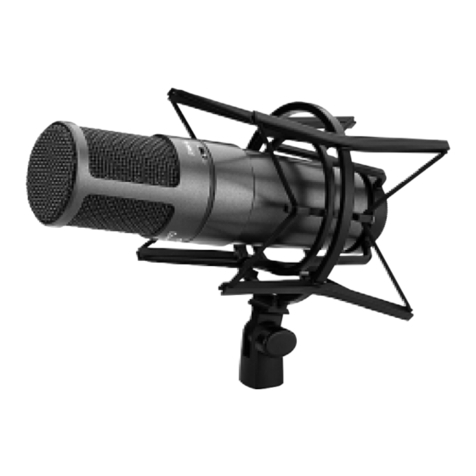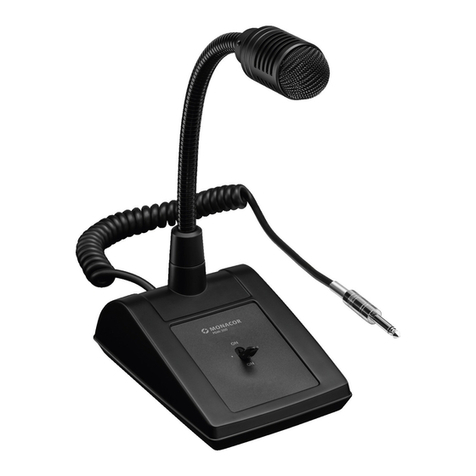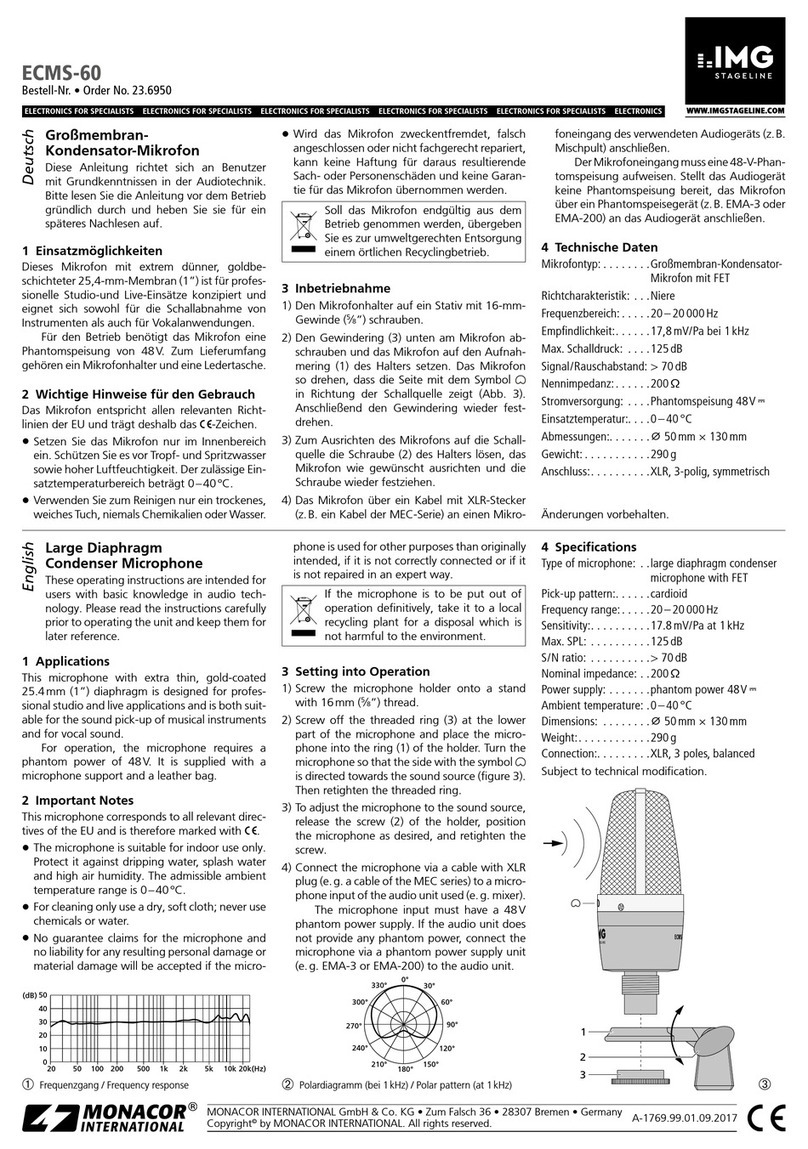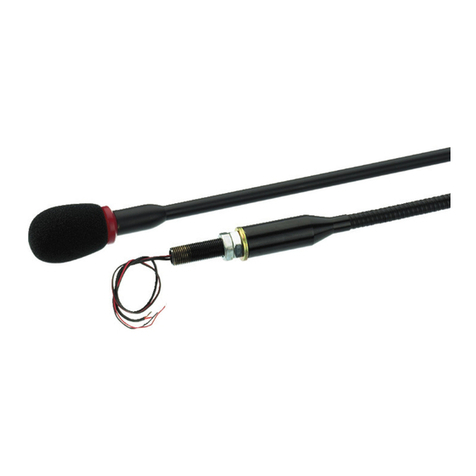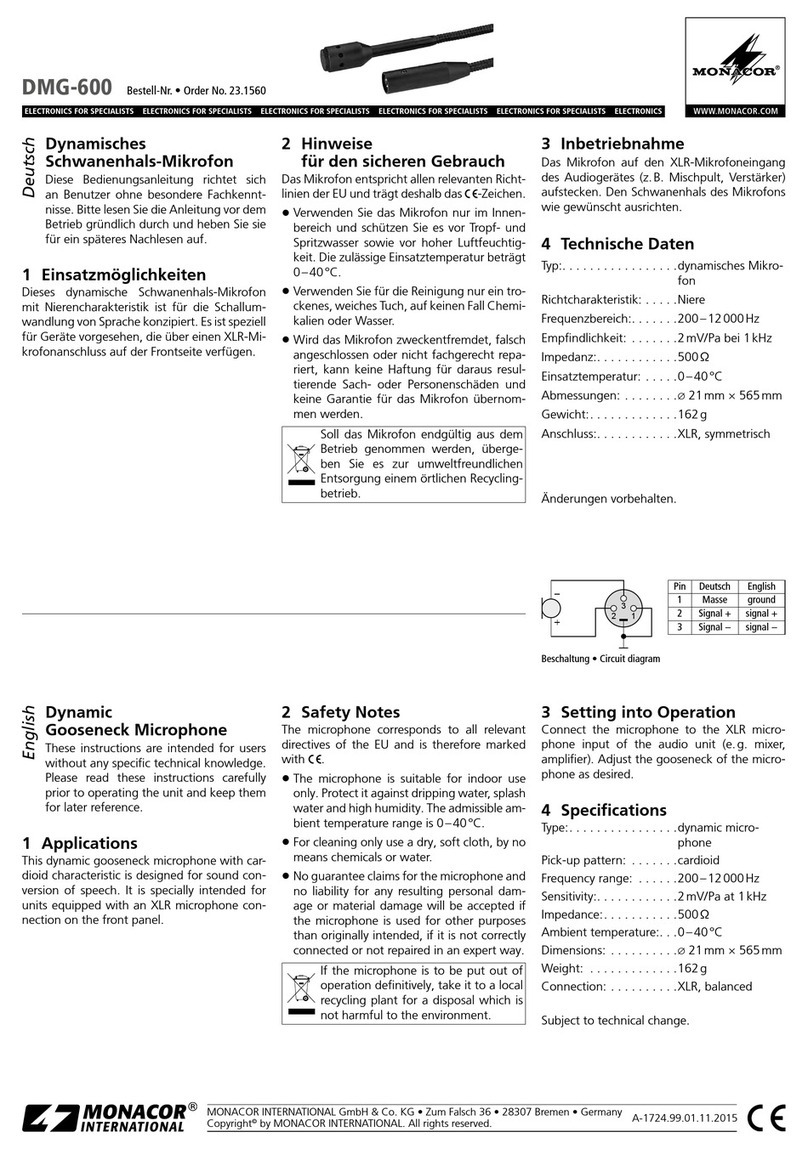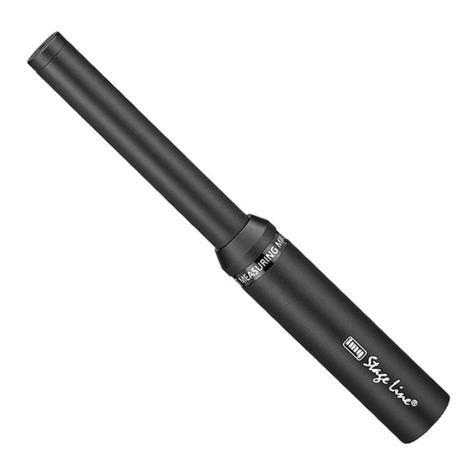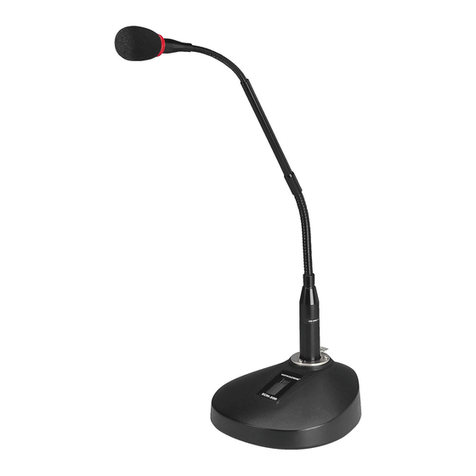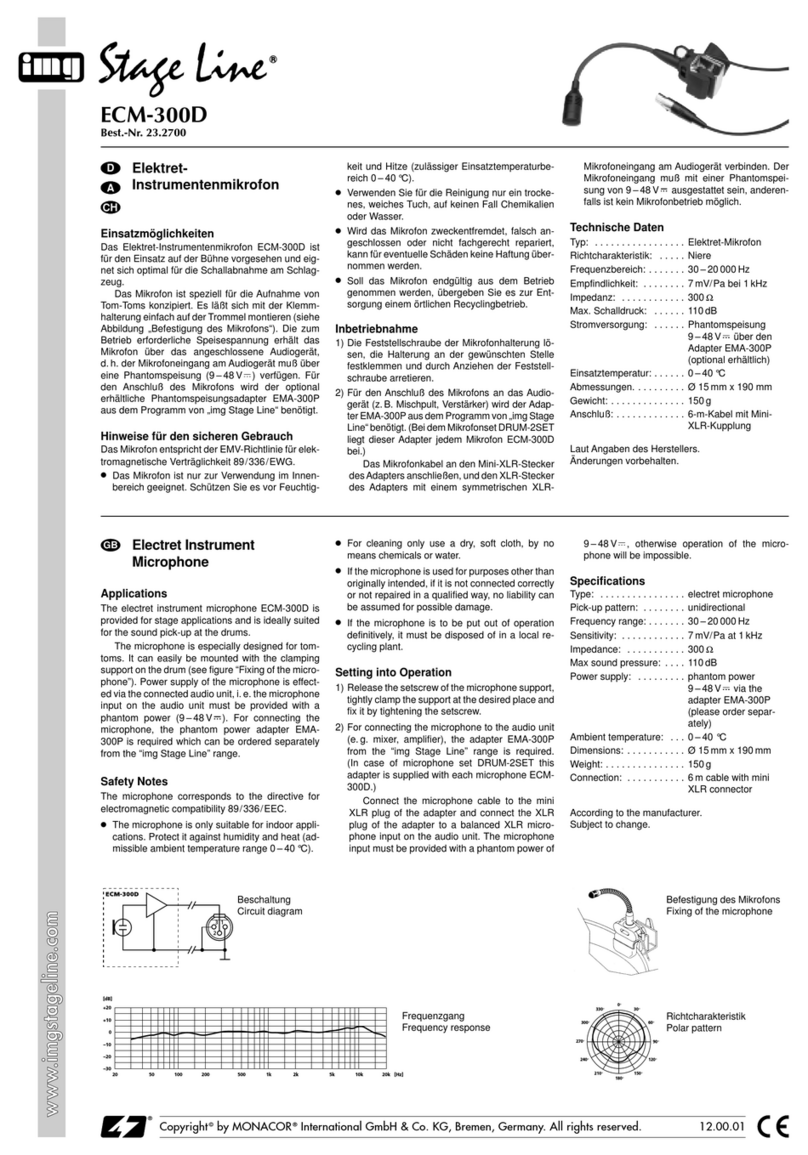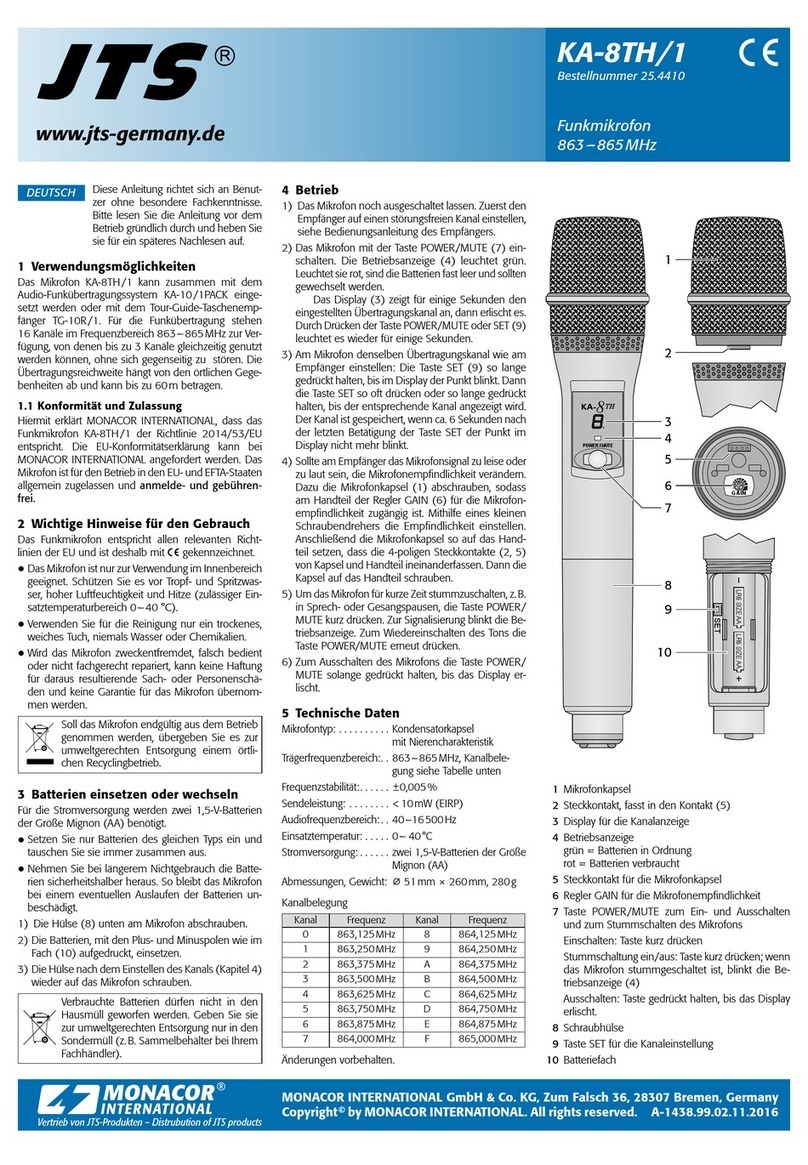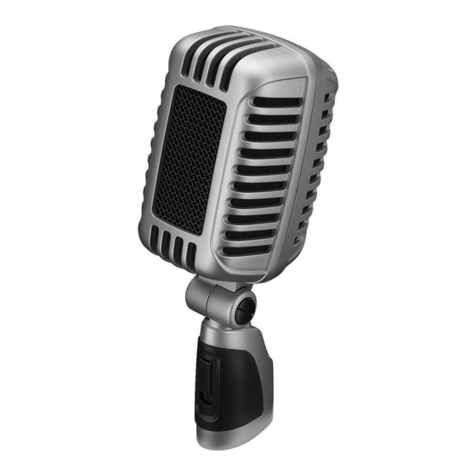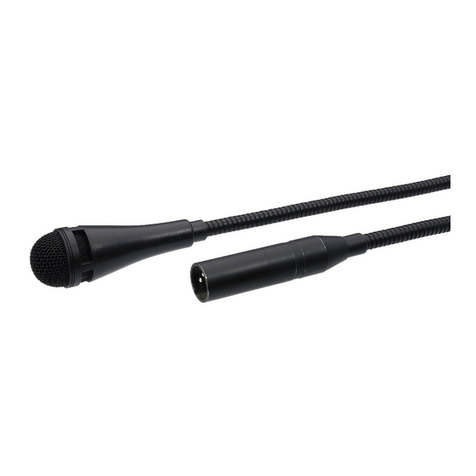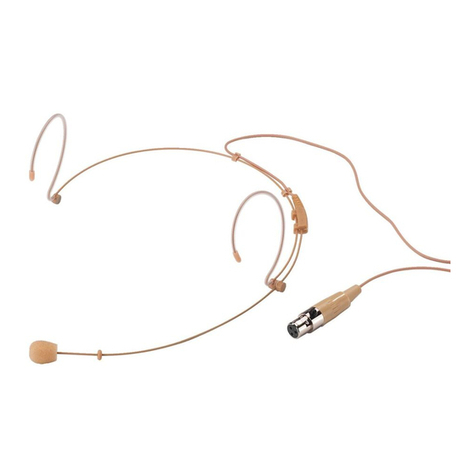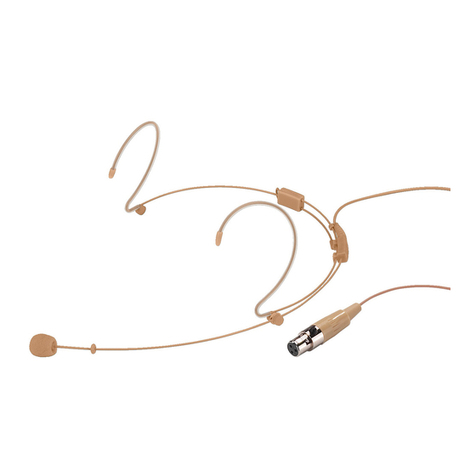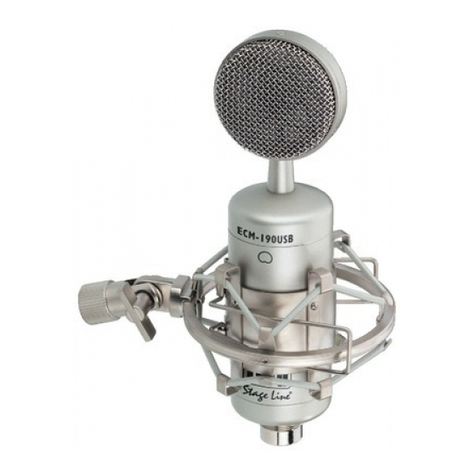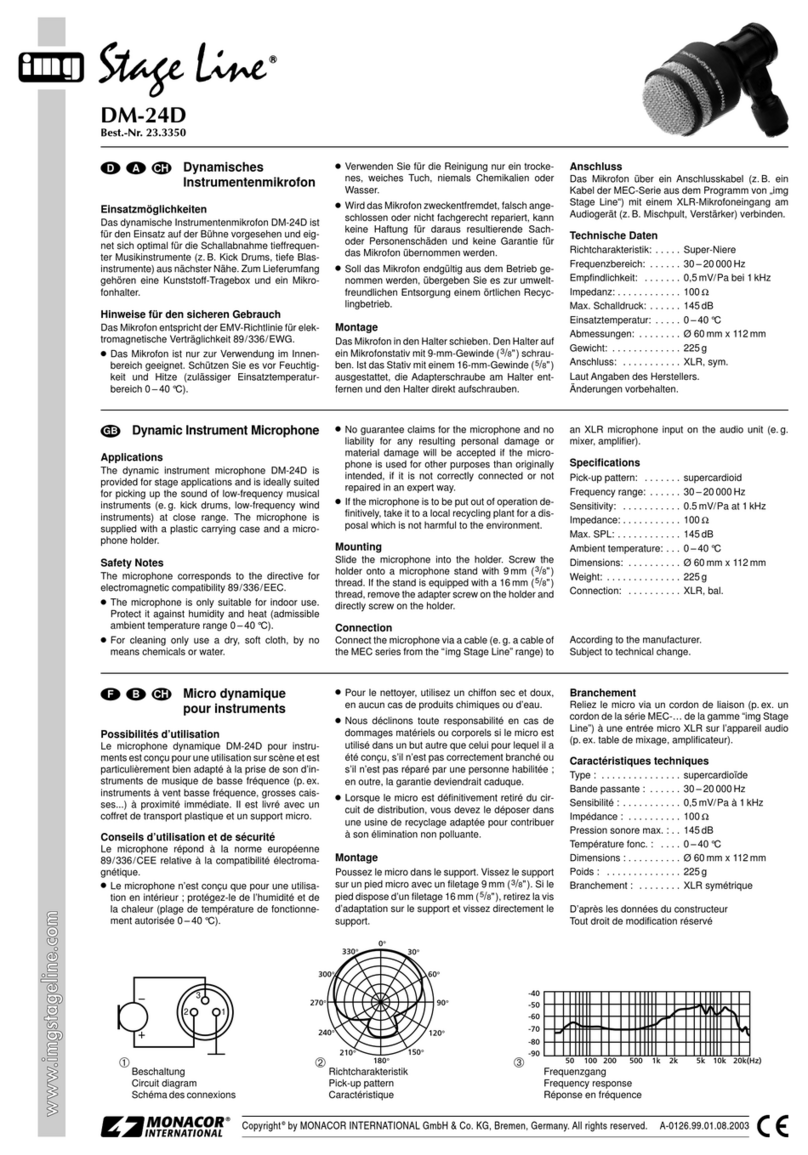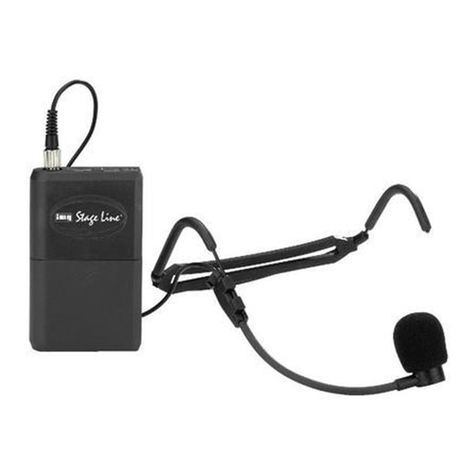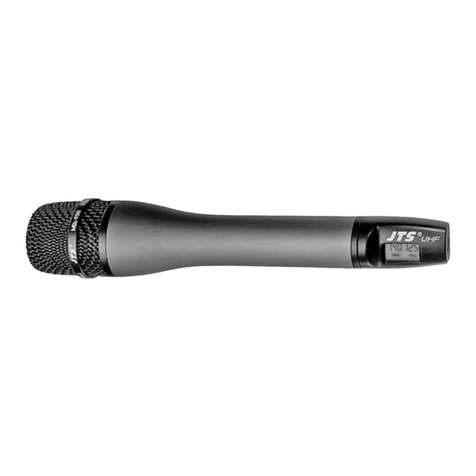
ELECTRONICS FOR SPECIALISTS ELECTRONICS FOR SPECIALISTS ELECTRONICS FOR SPECIALISTS ELECTRONICS FOR SPECIALISTS ELECTRONICS FOR SPECIALISTS ELECTRONICS
HSE-72
Bestell-Nr. • Order No. 23.6410
MONACOR INTERNATIONAL GmbH & Co. KG • Zum Falsch 36 • 28307 Bremen • Germany
Copyright©by MONACOR INTERNATIONAL. All rights reserved. A-1560.99.02.12.2017
2
3 1
2k2
Micrófono de Cabeza
Estas instrucciones de funcionamiento van dirigi-
das a usuarios sin ningún conocimiento técnico
específico. Lea atentamente las instrucciones
antes de utilizar el micrófono y guárdelas para
usos posteriores.
1 Aplicaciones
Este micrófono de cabeza está diseñado para utilizarse
en combinación con un emisor de petaca de un sis-
tema de transmisión de audio inalámbrico (p.ej. un
emisor de petaca TXS-…HSE con conexión mini XLR
de 3 polos). Está diseñado especialmente para sonido
vocal y discursos que necesiten mucha libertad de
movimiento, p.ej. para escenario.
Como alternativa para el funcionamiento con un
emisor de petaca, el micrófono se puede conectar a
un aparato de audio, p.ej. un mezclador, mediante un
adaptador de alimentación (p.ej. EMA-1) que suminis-
tre corriente al micrófono.
2 Notas Importantes
El micrófono cumple con todas las directivas relevantes
de la UE y por lo tanto está marcado con el símbolo .
•
El micrófono está adecuado sólo para utilizarlo en
interiores. Protéjalo de la humedad y del calor (tem-
peratura ambiente admisible: 0–40°C).
•
Utilice sólo un paño suave y seco para la limpieza; no
utilice nunca ni agua ni productos químicos.
•
No podrá reclamarse garantía o responsabilidad
alguna por cualquier daño personal o material re-
sultante si el micrófono se utiliza para otros fines
diferentes a los originalmente concebidos, si no se
conecta adecuadamente o no se repara por expertos.
Si va a poner el micrófono definitivamente
fuera de servicio, llévelo a la planta de reci-
claje más cercana para que su eliminación no
sea perjudicial para el medioambiente.
3 Puesta en Marcha
Coloque la espuma de protección entregada en el
micrófono. Póngase la diadema y coloque el micró-
fono en una posición óptima; el brazo del micrófono
se doblará en cualquier dirección.
Conecte el micrófono a la entrada del emisor de
petaca o conéctelo a la entrada de micrófono del
aparato de audio, utilizando un adaptador de alimen-
tación.
4 Especificaciones
Tipo:. . . . . . . . . . . . . . . . . Back electret
Captación: . . . . . . . . . . . . Cardioide
Rango de frecuencias:. . . . 50 – 16 000 Hz
Impedancia: . . . . . . . . . . . 2 kΩ
Sensibilidad: . . . . . . . . . . . 5,6 mV/ Pa a 1 kHz
SPL máximo: . . . . . . . . . . . 130 dB
Alimentación: . . . . . . . . . . ⎓1,5 – 9 V mediante
emisor de petaca o adap-
tador de alimentación
Peso:. . . . . . . . . . . . . . . . . 28 g
Conexión:. . . . . . . . . . . . . Mini XLR, 3 polos
Configuración de pines: . 1 = masa
2 = señal de audio
3 = alimentación
Sujeto a modificaciones técnicas.
Microfono headset
Queste istruzioni sono rivolte all’utente senza
conoscenze tecniche specifiche. Vi preghiamo di
leggerle attentamente prima della messa in fun-
zione e di conservarle per un uso futuro.
1 Possibilità d‘impiego
Questo microfono headset è previsto per l‘uso con
il trasmettitore tascabile di un sistema wireless di
trasmissione audio (p.es. un trasmettitore tascabile
TXS-...HSE con contatto mini XLR a 3 poli). Pertanto
è adatto in modo ottimale per applicazioni di canto e
di voce parlata che richiedono molta libertà di movi-
mento, per esempio per spettacoli.
In alternativa al funzionamento con un trasmetti-
tore tascabile, il microfono può essere collegato anche
con un apparecchio audio, p.es. un mixer, per mezzo
di un adattatore di alimentazione (p.es. EMA-1), che
mette a disposizione l‘alimentazione del microfono.
2 Avvertenze importanti
Il microfono è conforme a tutte le direttive rilevanti
dell’UE e pertanto porta la sigla .
•
Il microfono è adatto solo per l’uso all’interno di lo-
cali. Proteggerlo dall‘umidità e dal calore (tempera-
tura d’impiego ammessa fra 0 e 40°C).
•
Per la pulizia usare solo un panno morbido, asciutto;
non impiegare mai acqua o prodotti chimici.
•
Nel caso d’uso improprio, di collegamenti sbagliati o
di riparazione non a regola d’arte del microfono, non
si assume nessuna responsabilità per eventuali danni
consequenziali a persone o a cose e non si assume
nessuna garanzia per il microfono.
Se si desidera eliminare il microfono definiti-
vamente, consegnarlo per lo smaltimento ad
un’istituzione locale per il riciclaggio.
3 Messa in funzione
Coprire il microfono con la cuffia antivento di ma-
teriale espanso in dotazione. Sistemare l’archetto in
testa e portare il microfono in una buona posizione
per parlare. A tale scopo è possibile piegare il braccio
del microfono in tutte le direzioni.
Collegare il microfono con l‘ingresso del trasmet-
titore tascabile oppure collegarlo con l‘ingresso micro-
fono di un apparecchio audio servendosi di un adatta-
tore d‘alimentazione.
4 Dati tecnici
Tipo:. . . . . . . . . . . . . . . . back-electret
Caratteristica direzionale: cardioide
Gamma di frequenze: . . . 50 – 16 000 Hz
Impedenza:. . . . . . . . . . . 2 kΩ
Sensibilità: . . . . . . . . . . . 5,6 mV/ Pa con 1 kHz
Pressione sonora max.: . . 130dB
Alimentazione: . . . . . . . . ⎓1,5–9V tramite trasmet-
titore tascabile o adattatore
d‘alimentazione
Peso:. . . . . . . . . . . . . . . . 28 g
Contatto: . . . . . . . . . . . . XLR mini, 3 poli
Piedinatura: . . . . . . . . . 1 = massa
2 = segnale audio
3 = alimentazione
Con riserva di modifiche tecniche.
Mikrofon nagłowny
Niniejsza instrukcja przeznaczona jest dla użyt-
kowników, którzy nie posiadają wiedzy i do-
świadczenia technicznego. Przed rozpoczęciem
użytkowania proszę zapoznać się z instrukcją, a
następnie zachować ją do wglądu.
1 Zastosowanie
Mikrofon nagłowny przystosowany jest do współpracy
z nadajnikiem kieszonkowym bezprzewodowego sys-
temu transmisji audio (np. nadajnikiem TXS-…HSE,
wyposażonym w 3-pinowe złącze miniXLR). Przezna-
czony jest do zastosowań muzycznych oraz konferen-
cyjnych, wymagających dużej swobody ruchu np. przy
występach na scenie.
Alternatywnie, możliwe jest podłączenie mikro-
fonu do wejścia w urządzeniu audio np. mikserze.
Wymagany do tego jest adapter z zasilaniem phantom
(np.EMA-1).
2 Środki bezpieczeństwa
Mikrofon spełnia wszystkie wymagania norm UE i dla-
tego został oznaczony symbolem .
•
Mikrofon przeznaczony jest do użytku jedynie we-
wnątrz pomieszczeń. Należy chronić go przed dzia-
łaniem wilgoci oraz wysokiej temperatury (dopusz-
czalna temperatura otoczenia: 0–40°C).
•
Do czyszczenia urządzenia należy używać suchej,
miękkiej tkaniny. Nie stosować wody, ani chemicz-
nych środków czyszczących.
•
Producent ani dostawca nie ponoszą odpowiedzial-
ności za wynikłe szkody (uszkodzenie sprzętu lub ob-
rażenia użytkownika), jeśli urządzenie było używane
niezgodnie z przeznaczeniem, nieprawidłowo pod-
łączone bądź poddane nieautoryzowanej naprawie.
Jeśli mikrofon nie będzie już więcej używany,
wskazane jest przekazanie go do miejsca uty-
lizacji odpadów, aby został zniszczony bez
szkody dla środowiska.
3 Przygotowanie do pracy
Założyć piankowy wiatrochron na wkładkę mikrofo-
nową. Założyć uchwyt mikrofonu na głowę i umieścić
wkładkę mikrofonową w pobliżu ust. Ramię wkładki
może być wyginane w dowolną stronę.
Podłączyć mikrofon do wejścia w nadajniku kie-
szonkowym lub do wejścia mikrofonowego w urzą-
dzeniu audio – poprzez adapter z zasilaniem.
4 Specyfikacja
Typ:. . . . . . . . . . . . . . . . . . . . back electret
Charakterystyka kierunkowa: kardioida
Pasmo przenoszenia:. . . . . . . 50 – 16 000 Hz
Impedancja: . . . . . . . . . . . . . 2kΩ
Czułość: . . . . . . . . . . . . . . . . 5,6 mV/ Pa przy 1 kHz
Max poziom SPL: . . . . . . . . . 130 dB
Zasilanie:. . . . . . . . . . . . . . . . ⎓1,5 – 9 V z nadajnika
kieszonkowego lub
adaptera zasilania
Waga:. . . . . . . . . . . . . . . . . . 28g
Złącze: . . . . . . . . . . . . . . . . . mini XLR, 3-pinowy
Konfiguracja pinów: . . . . . . 1 = masa
2 = sygnał audio
3 = zasilanie
Z zastrzeżeniem możliwości zmian.
Italiano
Español
Polski



